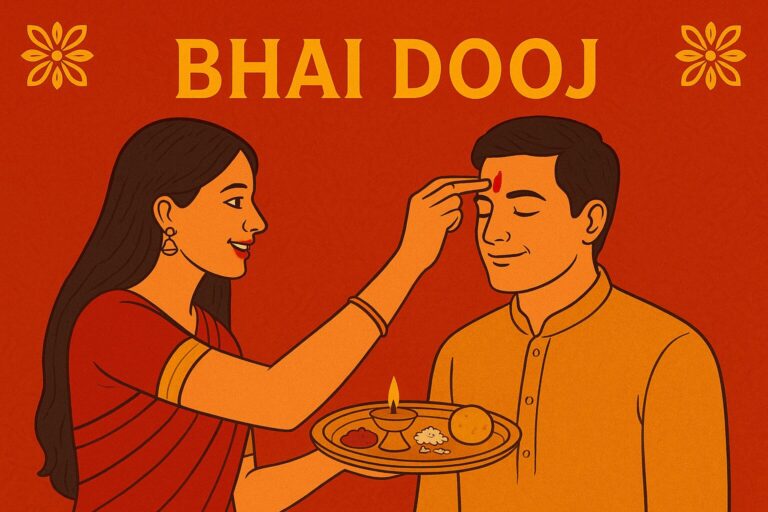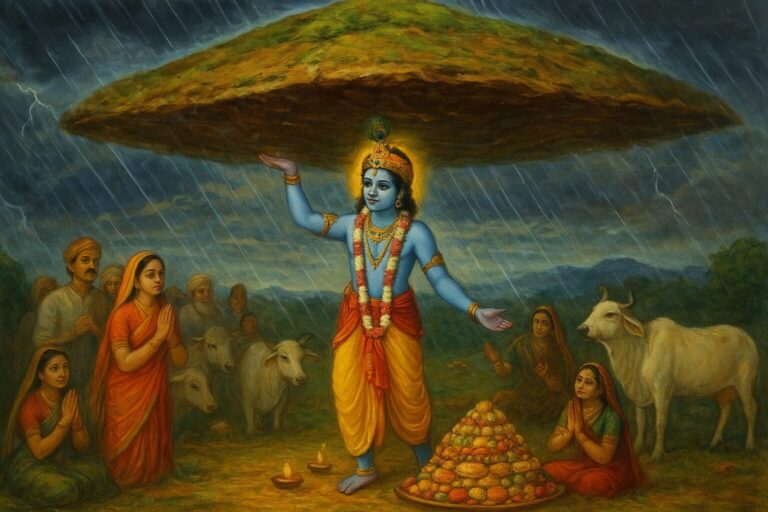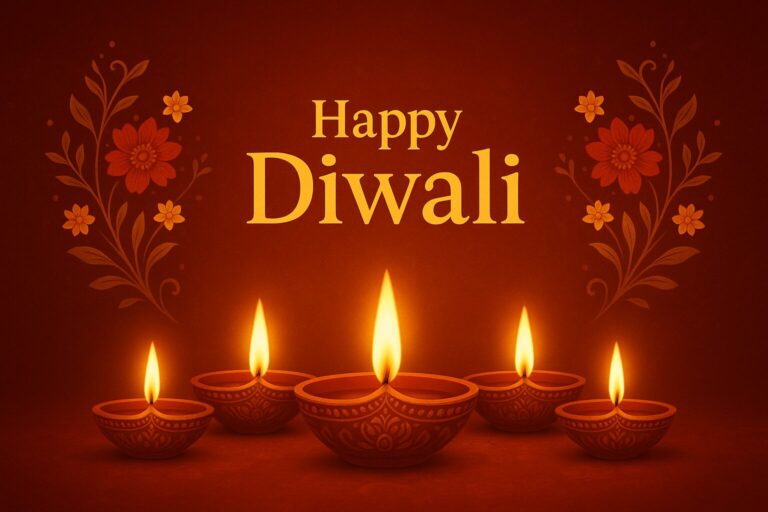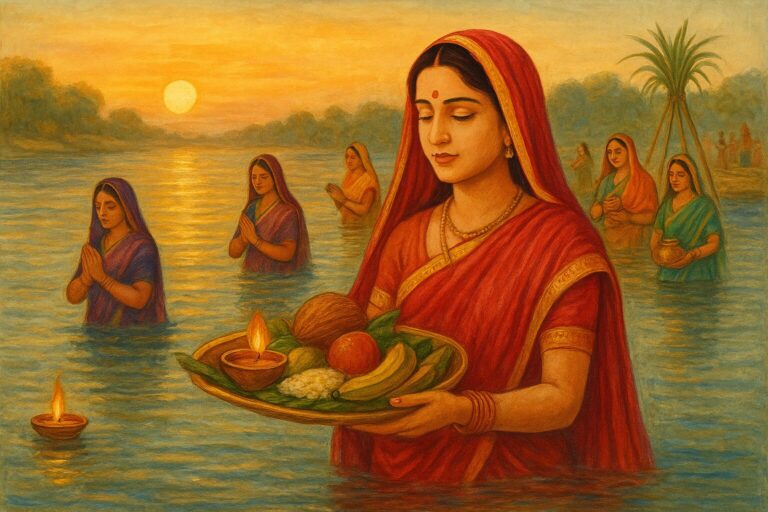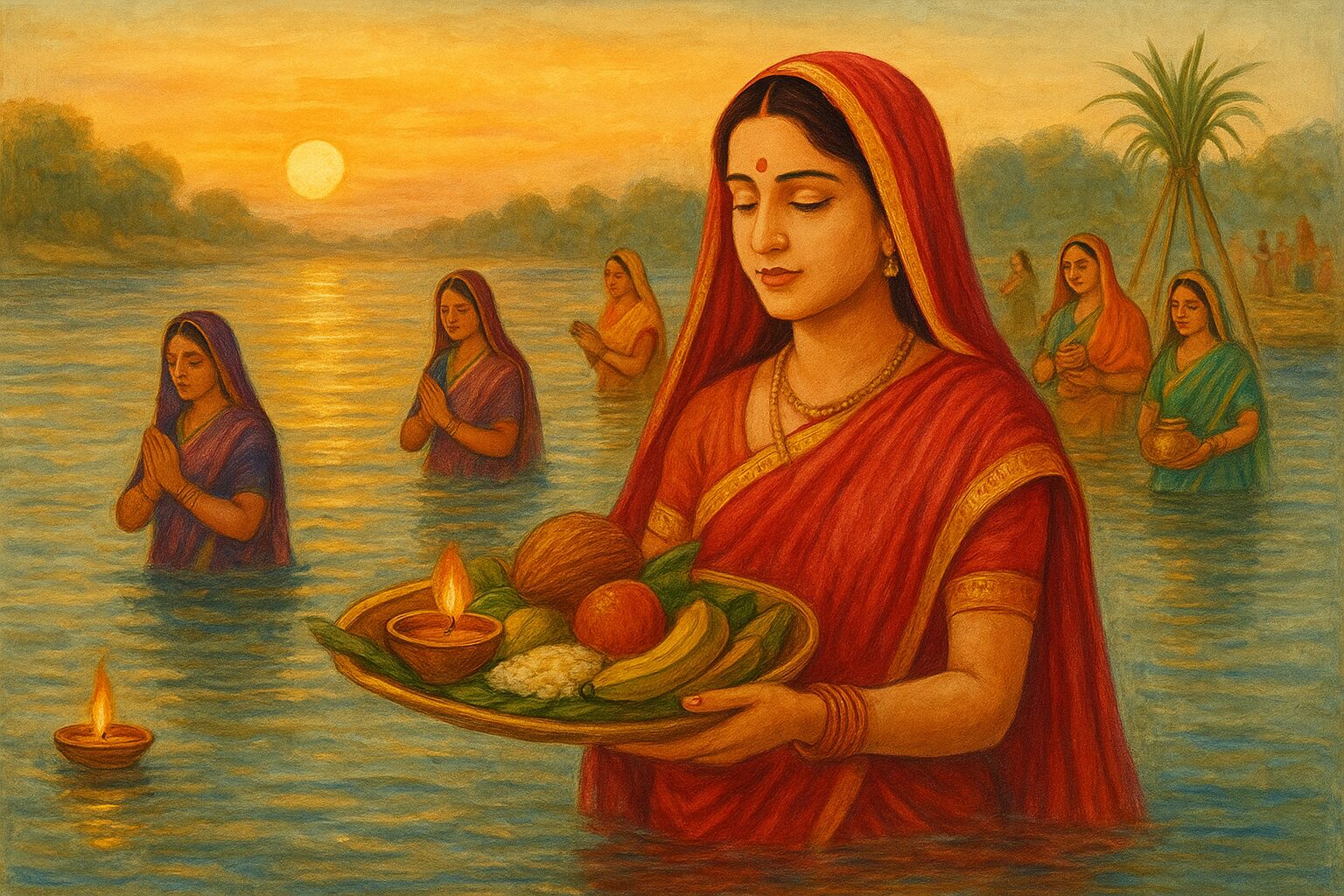
From Thekua to Ganga Ghats Discover the Magic of Chhath Puja 2025
As October’s cool breeze replaces the warmth of the monsoon, India’s riverbanks begin to glow with faith and devotion. The sight is mesmerizing- devotees dressed in traditional attire stand waist-deep in water, offering prayers to the setting and rising sun. This serene and sacred moment marks the celebration of Chhath Puja, one of the most heartfelt festivals in India that blends spirituality, discipline, and nature worship.
Chhath Puja is devoted to Lord Surya (the Sun God) and his sister Chhathi Maiya, revered as the goddess of well-being and prosperity. For four days, devotees observe strict rituals from fasting and bathing in holy rivers to preparing natural offerings of fruits and grains. No idols are used, no priests are needed; prayers are made directly to the Sun with pure intention and gratitude. The main offerings, known as Arghya, are made during sunset on the third day and sunrise on the fourth day, symbolizing balance, renewal, and thankfulness for life’s energy.
In 2025, Chhath Puja will be observed in late October, with grand celebrations across Bihar, Uttar Pradesh, Jharkhand, Nepal, and among Indian communities around the globe. The festival beautifully showcases devotion, discipline, and a deep connection between humanity and nature’s eternal light.
History and Cultural Significance of Chhath Puja
Ancient Origins
Chhath Puja has deep roots in India’s spiritual traditions, even though detailed textual references are limited. The practice of sun worship, central to Chhath, can be traced back to the Vedic period. Ancient texts, including the Rigveda, celebrate Surya Dev as the source of life and energy. Rituals such as offering water at sunrise and sunset, fasting, and standing in rivers or ponds reflect these age-old traditions, passed down through generations.
Today, Chhath Puja is observed as a four-day solar festival, primarily in Bihar, Uttar Pradesh, Jharkhand, and parts of Nepal. Its distinctive feature is the offering of Arghya directly to the rising and setting sun, without using idols or priests, highlighting its unique spiritual simplicity and purity.
Mythological and Folk Narratives
The festival is steeped in rich regional folklore and mythology. One popular legend tells of King Priyavrata, son of Manu, whose stillborn child was revived through the blessings of Chhathi Maiya after the king undertook strict fasting and offered prayers to Surya.
Another connection is found in the Mahabharata. During their exile, the Pandavas’ mother is said to have observed rigorous sun-vows similar to Chhath to protect her children’s future. Even Karna, the son of Surya, is believed to have worshipped his father by standing in water and performing charitable acts, honoring the sun’s divine energy.
In popular belief, Chhathi Maiya is seen in multiple forms: sometimes as Surya’s sister, at other times as the personification of dawn (Ushas), and often as a guardian mother of children and family well-being. This blend of solar worship, maternal devotion, and communal thanksgiving gives Chhath Puja its distinct identity, making it a festival that is spiritual, nurturing, and socially unifying.
Why Chhath Puja Matters
Chhath Puja is known for its intense spiritual and physical discipline. Devotees undertake long fasts, stand in water for hours, and often maintain complete silence during prayers. These practices help cultivate self-control, inner peace, and humility, allowing worshippers to experience deep spiritual cleansing and focus.
1. A Practice of Spiritual Discipline
Chhath Puja is known for its intense spiritual and physical discipline. Devotees undertake long fasts, stand in water for hours, and often maintain complete silence during prayers. These practices help cultivate self-control, inner peace, and humility, allowing worshippers to experience deep spiritual cleansing and focus.
2. A Celebration of Gratitude and Nature
The festival is celebrated at the end of the harvest season, just before winter begins. It serves as a sacred moment to thank the Sun God, the Earth, and water bodies—the natural forces that sustain life. Through prayers and offerings, devotees express gratitude for abundance, fertility, and the simple blessings of nature.
3. Strengthening Community and Cultural Identity
For people in Bihar, eastern Uttar Pradesh, Jharkhand, and the Mithila region of India and Nepal, Chhath Puja is more than a ritual—it is a symbol of cultural pride and unity. During the festival, river ghats are decorated with bamboo arches, diyas, and folk songs fill the air. Families gather, neighbors celebrate together, and generations reconnect through shared tradition and devotion.
4. A Message of Environmental Harmony
Chhath Puja beautifully blends spirituality with sustainability. The rituals emphasize clean riverbanks, eco-friendly offerings, and the use of natural materials like bamboo baskets (soop) and clay lamps. By offering seasonal fruits and grains, the festival teaches respect for nature and the importance of environmental balance, making it one of India’s most eco-conscious celebrations.
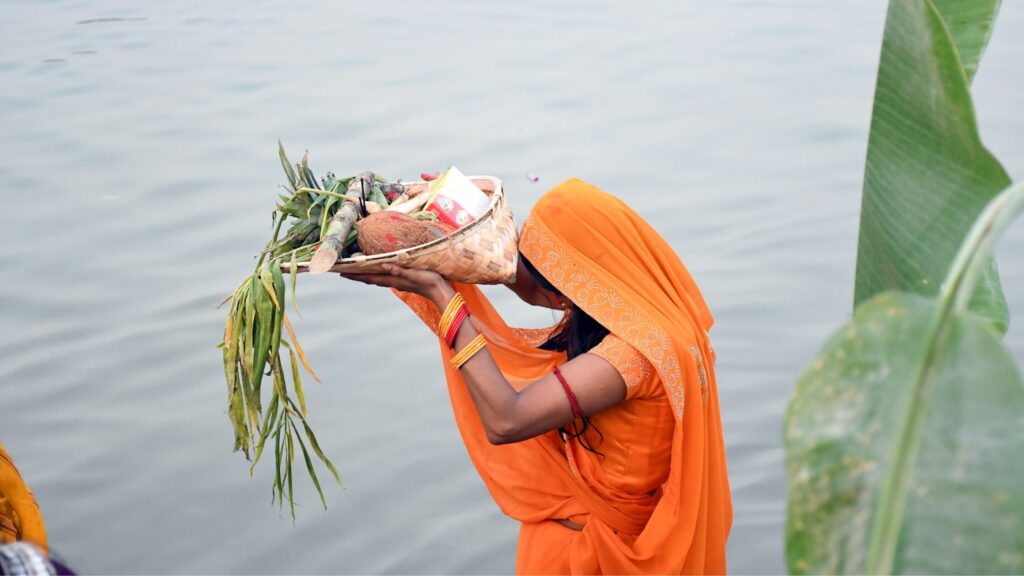
The Four-Day Ritual & Meaning
Chhath Puja is a deeply spiritual and eco-conscious Hindu festival dedicated to Surya Dev (the Sun God) and Chhathi Maiya, observed mainly in Bihar, Uttar Pradesh, Jharkhand, and parts of Nepal. The festival spans four days of strict rituals, devotion, and gratitude, each with its own symbolic meaning and spiritual significance.
Day 1: Nahay Khay- Cleansing and Preparation
Date: October 25, 2025 (Saturday)
The festival begins with Nahay Khay, a day dedicated to purification. Devotees take a holy dip in rivers, ponds, or other natural water bodies early in the morning. This act represents spiritual and physical cleansing, marking the start of a sacred vow.
After bathing, devotees eat a simple, satvik (pure vegetarian) meal prepared usually rice, dal, and seasonal vegetables. This signifies simplicity and readiness for the upcoming fasts. Homes are cleaned and decorated with rangoli, banana leaves, and diyas, creating an atmosphere of purity and devotion.
Symbolism: Nahay Khay represents letting go of worldly distractions and focusing on spiritual discipline and devotion.
Day 2: Kharna – Fasting and Evening Prasad
Date: October 26, 2025 (Sunday)
The second day marks the beginning of the main fast, where devotees abstain from food and, in many cases, even water (nirjala vrat) from sunrise to sunset.
At dusk, an offering of kheer (rice pudding made with jaggery), puri or chapati, and seasonal fruits is prepared. Devotees first offer this prasad to the Sun and then partake in it, marking the completion of the day’s fast. After this, a 36-hour waterless fast begins for those observing the full ritual.
Cooking during Kharna is done with utmost purity on a traditional chulha (earthen stove) using mango wood and new utensils. The entire process is devotional, symbolizing the blending of simplicity, sanctity, and family participation.
Symbolism: Kharna teaches self-restraint, inner strength, and the balance between renunciation and gratitude.
Day 3: Sandhya Arghya- Evening Offerings to the Setting Sun
Date: October 27, 2025 (Monday)
This is the most visually stunning and spiritually charged part of Chhath Puja. As the sun begins to set, thousands of devotees gather along riverbanks and ponds with soop (bamboo winnowing baskets) filled with offerings like thekua (traditional sweet), fruits, coconuts, sugarcane stalks, and seasonal vegetables.
Five sugarcane stalks are tied together to form a symbolic canopy, representing the five elements of nature earth, water, fire, air, and sky. Diyas (earthen lamps) are lit, and devotees offer arghya (a mix of water and milk) to the setting sun, accompanied by devotional Chhath geet (folk songs).
Families often stay overnight near the ghats, singing and praying under the open sky, creating a divine and communal atmosphere.
Symbolism: The setting sun represents gratitude, humility, and the end of one cycle of life, while preparing for renewal with the dawn.
Day 4: Usha Arghya and Parana – Prayers to the Rising Sun
Date: October 28, 2025 (Tuesday, Early Dawn)
The final day, known as Usha Arghya, begins before sunrise. Devotees gather again at the ghats to offer prayers to the rising sun, marking new beginnings and hope. Standing waist-deep in water, they offer arghya as the first rays of sunlight touch the horizon—a breathtaking sight symbolizing life, light, and gratitude.
After this sacred offering, devotees break their 36-hour fast during the ritual known as Parana. Prasad including thekua, fruits, and sugarcane is distributed among family, friends, and neighbors. A heartwarming custom called Khoichh follows, where elder women bless younger ones by giving them prasad in clay pots.
Symbolism:
The rising sun represents renewal, vitality, and the eternal rhythm of life. The festival concludes, but its message of purity, unity, and thankfulness endures.
2025 Dates & Muhurat Highlights
For 2025, the festival calendar (general) is:
- Day 1 – Nahay Khay: October 25, 2025 (Saturday)
- Day 2 – Kharna: October 26, 2025 (Sunday)
- Day 3 – Sandhya Arghya: October 27, 2025 (Monday)
- Day 4 – Usha Arghya & Parana: October 28, 2025 (Tuesday, early dawn)
Important: The exact times of setting & rising sun, tithi (Shashthi), and arghya muhurats vary by location. For example, cities like Patna, Varanasi, Ranchi will have slightly different sunrise/sunset times and the ghats will publish local schedules. It’s wise to embed a dynamic panchang for city-specific timing.
Regional Variations and Cultural Colours of Chhath Puja
Although the rituals of Chhath Puja remain the same everywhere four days of fasting, cleanliness, and offering “arghya” to the Sun the way people celebrate it changes from region to region. Each place adds its own touch of tradition, culture, and community spirit to this festival of faith.
Bihar- The Heart of Chhath Puja
Bihar is known as the birthplace and main centre of Chhath Puja. Here, the festival is celebrated with unmatched devotion and grandeur. Every riverbank, especially along the Ganga in Patna, Muzaffarpur, Bhagalpur, and Darbhanga, glows with lights and diyas as thousands gather to offer prayers to the Sun.
- Beautifully decorated ghats with bamboo arches, marigold flowers, and diyas.
- Women sing traditional Chhath Geet in Bhojpuri and Maithili throughout the night.
- Families prepare homemade offerings like thekua, fruits, sugarcane, and coconuts.
- Villages unite at one common pond or riverbank, turning the celebration into a community festival.
Eastern Uttar Pradesh (Purvanchal)
In eastern UP especially in cities like Varanasi, Ballia, and Deoria Chhath Puja has both UP and Bihar influences. Devotees offer arghya on the banks of the Ganga and smaller ponds.
- People from nearby regions and states join in large numbers.
- Folk songs and rituals are similar to Bihar but in slightly different dialects.
- Railways and local bodies often make special arrangements for the devotees.
Jharkhand- A Blend of Faith and Nature
In Jharkhand, Chhath Puja is celebrated with a mix of traditional and tribal customs. The festival takes place around rivers, lakes, and dams in both villages and cities like Ranchi and Jamshedpur.
- Community cleaning drives before the festival show respect for nature.
- Local forest produce and seasonal fruits are used in offerings.
- Artificial ponds and tanks are built for urban devotees.
West Bengal and Other Indian States
In Kolkata and other parts of West Bengal, large numbers of Bihari and Jharkhandi families celebrate Chhath Puja. Since not everyone has access to natural water bodies, temporary ponds are created in parks or near apartments.
- Community Chhath ghats with music, lights, and decorations.
- Bhojpuri and Bengali songs add a multicultural touch.
- Cultural programmes with folk dances and devotional songs are also held.
Nepal and the Global Diaspora
Chhath Puja is not limited to India. It is also celebrated in Nepal’s Terai region especially in Madhesh, Koshi, and Bagmati where customs are very similar to Bihar.
In countries like Mauritius, the USA, UK, Canada, and the Caribbean, Indian communities recreate the festival using swimming pools, lakes, or large containers of water. This helps keep the culture alive far from home.
Top Sun Temples & Places of Worship
The Sun has always held a special place in India’s spiritual traditions. For those who love history, architecture, and travel, visiting ancient Sun temples during or around Chhath Puja can be a deeply enriching experience. These temples not only showcase India’s artistic brilliance but also reflect the centuries-old tradition of sun worship that Chhath Puja continues to honor.
1. Konark Sun Temple, Odisha
One of India’s most iconic landmarks, the Konark Sun Temple is a UNESCO World Heritage Site built in the 13th century by King Narasimhadeva I. Designed as a massive stone chariot with twelve pairs of carved wheels and seven horses, the temple captures the power and movement of the Sun.
- Best time to visit: Early morning at sunrise, when the first rays illuminate the carvings.
- Why visit during Chhath: The temple’s alignment with the east makes it ideal for offering prayers to the rising Sun, symbolically connecting it to the Chhath tradition.
2. Modhera Sun Temple, Gujarat
Built in the 11th century by King Bhima I of the Solanki dynasty, the Modhera Sun Temple is one of the finest examples of Indian temple architecture. It is scientifically designed so that the first rays of the rising Sun fall directly on the deity inside the sanctum.
- Highlights: Stunning stepwell (Surya Kund) and intricate sculptures.
- Best time to visit: Around sunrise, especially near the spring or autumn equinox.
- Chhath connection: The temple celebrates the same reverence for the Sun as seen in Chhath Puja rituals.
3. Martand Sun Temple, Jammu and Kashmir
Located near Anantnag, the Martand Sun Temple was built in the 8th century by King Lalitaditya Muktapida. Though now in ruins, its majestic stone structure still speaks of grandeur and devotion.
- Special feature: Breathtaking Himalayan backdrop and historic significance.
- Why visit: It is one of the earliest known temples dedicated to Surya in North India and a serene place for meditation and sunrise viewing.
4. Katarmal Sun Temple, Uttarakhand
Hidden in the scenic Kumaon hills near Almora, the Katarmal Sun Temple is more than 800 years old. Built by the Katyuri king Katarmalla, it stands as the second most important Sun temple in India after Konark.
- Highlights: Stone carvings, peaceful surroundings, and a natural pond for ritual bathing.
- Best time to visit: Sunrise, when the temple glows with golden sunlight.
- Chhath significance: The temple’s setting makes it a perfect spot for offering Arghya in the calm of the Himalayas.
5. Umga Sun Temple, Bihar
Located in the Madanpur area of Aurangabad district, the Umga Sun Temple is an ancient shrine revered by devotees from Bihar and Jharkhand.
Travel tip: The temple is surrounded by natural beauty and is close to several ghats used for traditional Chhath offerings.
Importance: A regional centre of solar worship where many locals perform rituals similar to those in Chhath Puja.
Best time to visit: During Chhath Puja or other solar festivals.
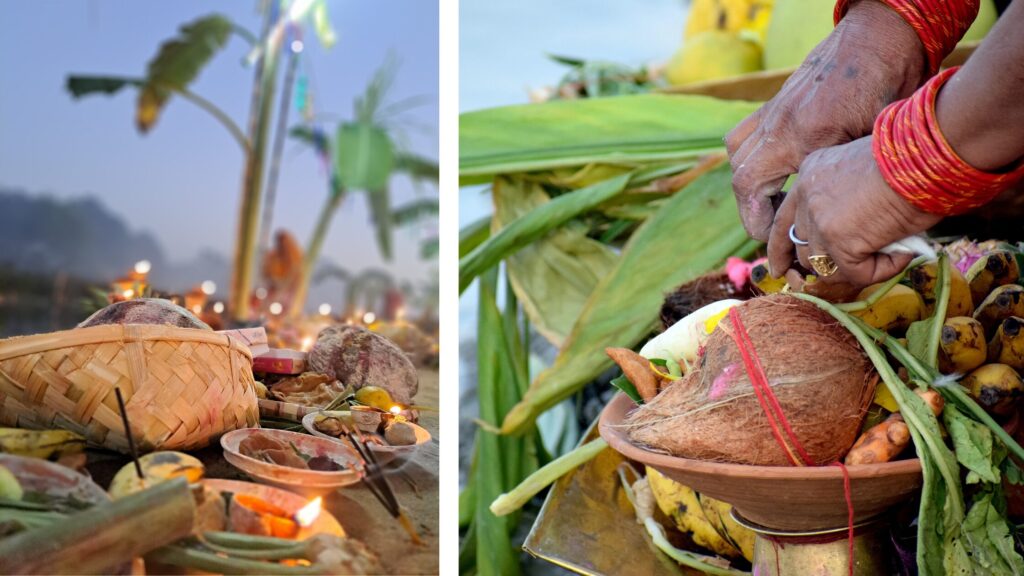
Food & Prasad: The Delicious Rituals
1. Thekua- The Soul of Chhath
Thekua is the most famous and sacred prasad of Chhath Puja. It’s a sweet, crisp cookie made from whole wheat flour, jaggery (or sugar), ghee, and cardamom, sometimes enriched with grated coconut or dry fruits. Fried or baked to golden perfection, Thekua is offered to the Sun God and later shared among family and devotees.
Symbolism: Thekua represents prosperity, hard work, and the sweetness of devotion.
2. Kheer (Gur Kheer or Kharna Kheer)
On the second day of Chhath, devotees prepare Gur Kheer, a rice pudding cooked with jaggery and milk. This dish marks the end of the day-long fast known as Kharna. It is shared with family members and neighbors as prasad.
Meaning: The Kheer signifies purity, simplicity, and the reward of patience after fasting.
3. Fresh Fruits and Sugarcane
Bananas, coconuts, apples, sugarcane stalks, and seasonal fruits are placed in bamboo baskets or banana leaves as offerings. These symbolize nature’s bounty and the gratitude of devotees toward the earth’s produce.
Tip: Using naturally ripened fruits is preferred, reflecting purity and respect for nature’s cycle.
4. Roasted Grains and Sattu
In many regions, roasted gram (chana), sattu (roasted gram flour), and puffed rice (muri) are included in the morning offerings. These light, protein-rich foods reflect simplicity and are often shared after the sunrise rituals.
Regional Touch: In some villages, sprouted grains are also used as a symbol of new life and renewal.
5. Light Sattvic Meals
During the fasting period, households follow strict dietary discipline. Meals are simple, made with seasonal vegetables, rock salt, and pure ghee completely free from onion, garlic, or any non-vegetarian item.
Purpose: This diet purifies the body and mind, helping devotees stay calm and focused during prayer.
Top Ghats & Locations for Chhath Puja
For anyone wishing to witness the divine beauty of Chhath Puja, the ghats of Bihar and neighbouring states offer an unforgettable experience. The sight of thousands of devotees standing waist-deep in the river, holding baskets filled with offerings for the Sun God, is truly mesmerizing. Here are some of the most famous and sacred places where Chhath Puja is celebrated with devotion and grandeur.
1. Gandhi Ghat, Patna (Bihar)
Gandhi Ghat is one of the most iconic and crowded Chhath Puja spots in India. Situated on the banks of the Ganga in Patna, it attracts thousands of devotees from across the state. As the sun rises and sets, the entire ghat glows with diyas and chants of Chhath Maiya ki Jai.
2. Other Prominent Ghats in Patna
Apart from Gandhi Ghat, several other ghats in Patna become major centers of worship during Chhath. Collectorate Ghat, Kankarbagh Ghat, Digha Ghat, and Bans Ghat all witness heavy footfall.
3. Varanasi- Assi Ghat & Dashashwamedh Ghat (Uttar Pradesh)
Varanasi, the spiritual heart of India, also celebrates Chhath Puja with great enthusiasm. The holy Ganga ghats Assi and Dashashwamedh attract thousands of devotees from Uttar Pradesh, Bihar, and other nearby regions.
4. Triveni Sangam, Prayagraj (Uttar Pradesh)
The sacred confluence of the Ganga, Yamuna, and Saraswati rivers is another important site for Chhath Puja. Although Prayagraj is best known for the Kumbh Mela, its ghats also host Chhath celebrations, especially by migrant families from Bihar and eastern UP.
5. Ghats and Ponds in Smaller Towns of Bihar
Chhath Puja is not limited to big cities. In towns like Muzaffarpur, Bhagalpur, Darbhanga, and Samastipur, local ghats and ponds turn into vibrant centers of devotion. Even small villages build temporary ponds (khola) for the rituals.
Top Chhath Songs
| Song Name | Artist/Singer | Language/Origin | Best Time to Play |
|---|---|---|---|
| Uga Hai Suraj Dev | Sharda Sinha | Bhojpuri / Maithili | Morning Arghya (Sunrise Puja) |
| Chhathi Maiya Ke Bhajan | Various Maithili Singers | Maithili | Throughout the festival |
| Kanch Hi Bans Ke Bahangiya | Kalpana / Sharda Sinha | Bhojpuri | Evening Puja preparations |
| Uthau Suruj Bhaile Bihaan | Traditional Folk | Bhojpuri | Morning Arghya |
| Hey Chhathi Maiya | Anuradha Paudwal | Hindi / Bhojpuri Mix | Evening Puja |
| Ho Deenanath | Traditional Chorus | Bhojpuri | Sandhya Arghya (Evening Puja) |
| Sona Jaisan Chamakta Deenanath | Pawan Singh / Folk Artists | Bhojpuri | Festival Night (Vigil) |
| Saama Khele Chalaali | Maithili Folk Singers | Maithili | Pre-Puja Celebration |
| Suruj Devta Ke Arghya | Sharda Sinha | Bhojpuri | Morning Arghya |
| Chhathi Maiya Aaw Daura | Various Folk Singers | Bhojpuri / Maithili | Festival Beginning |
Conclusion:
Chhath Puja is not just a religious festival it is a spiritual celebration of faith, purity, and nature’s harmony. As the sun sets and rises over India’s sacred rivers in 2025, millions of devotees will once again gather on the ghats, offering their heartfelt prayers to Surya Dev and Chhathi Maiya. From preparing thekua with devotion to singing traditional folk songs under the glowing sky, every ritual reflects the deep bond between humanity and nature. Chhath reminds us that gratitude, discipline, and togetherness are timeless virtues that continue to shine through generations.

